Viola pedata L.
Common names:
Bird's-foot Violet
Synonyms:
Viola pedata L. f. ranunculifolia (Juss. ex Poir.) Fernald, Rhodora 51: 56. 1949; Viola pedata L. var. ranunculifolia (Juss. ex Poir.) Ging. ex DC., in DC., Prodr. 1: 291. 1824
For other synonyms, see subordinate taxa.
Subordinate taxa belonging to this species:
Viola pedata L. var. pedata
Viola pedata L. var. cuneatiloba Brainerd ex Fernald
Viola pedata L. var. flabellata D.Don
Description:
Acaulescent rosulate perennials from thick barrel-like rhizome, ≤ 23 cm; foliage and peduncles gray-green, often finely red-spotted, glabrous or sparsely hispidulous; stipules adnate to petiole for most of their length, glandular-fimbriate; homophyllous, leaves erect to ascending, smaller leaf blades shallowly to moderately pedately divided, larger blades deeply pedately divided into usually 7–11 linear-oblanceolate lobes, 1 lobe in the terminal primary division and 3–5 in each lateral primary division, outline broadly ovate to reniform, base typically truncate to cordate, margins entire or with 1–2 subapical crenations or teeth on either side, apex broadly rounded, or rarely leaf blades obrhombic or obovate in outline and shallowly to moderately lobed due to partial fusion of leaf segments (var. pedata), or all leaf blades deeply "triternate" each primary division divided into a number of closely set short narrowly linear ultimate segments (var. cuneatiloba), or all leaf blades merely apically toothed or incised, outline oblanceolate to obspatulate or somewhat rhombic, base cuneate, apex acute (var. flabellata), largest ≤ 52 × 70 mm, margins ciliate; chasmogamous peduncle held above leaves; chasmogamous flower ≤ 30 mm; calyx glabrous, ciliate; lowest sepals linear-lanceolate, acuminate; auricles prominent, entire, not elongating in fruit; corolla pale to medium blue or upper petals purple-black, white throat color extending onto visible proximal portions of lateral and spurred petal, throat white; spur inconspicuous, slender; all petals glabrous; cleistogamous flowers lacking; capsule 5–10 mm, green drying brown, unspotted or commonly with dense fine red spots, glabrous; seeds 1.7–1.8 × 0.9–1.1 mm, medium orange-brown, unspotted; 2n=54.
Similar species:
This species is unique in its short erect barrel-like rhizome, long-adnate stipules, blue corolla (sometimes with upper petals purple-black) with all petals glabrous within, and a short slender cylindrical spur. The leaf blades of V. pedata subsp. pedata are superficially similar to those of Viola pedatifida and the two are commonly confused, but it differs most obviously in the undivided terminal primary division of the leaf blade, and glabrous petals (and the bicolorous corolla pattern). The other infraspecific taxa have more conspicuously unusual leaf blade division patterns and are even more divergent from other species in our region.
Ecology:
Dry sandy or gravelly soils in prairies, openings in oak savannas and xeric slopes in oak woods, often also on well drained roadbanks below forests.
Distribution:
Widely distributed in e. North America, NH to ND, south to s. GA and e. TX.
Rarity:
State listed in DE, OH, ON; and NH [as V. pedata var. pedata].
Phenology:
Chasmogamous flower March–July (Sepember-November), chasmogamous fruit May–July.
Affinities:
This species belongs to the monotypic Birds-foot Violet lineage, sect. Nosphinium W.Becker, subsect. Pedatae (Pollard) Brizicky.
Hybrids:
Russell and Bowen (1960) reported hybridization with V. primulifolia to account for the leaf morphology of var. flabellata; this hypothesis was not supported in unpublished studies with additional specimens by Harvey Ballard (pers. comm.).
Comments:
Brainerd (1921b), Russell (1965), Gleason and Cronquist (1991), McKinney (1992), Ballard (2000, 2013), Haines et al. (2011), and Voss and Reznicek (2012) recognized V. pedata without infraspecific taxa. Brainerd Baird (1942), Henry (1953a), Alexander (1963), Scoggan (1978), Strausbaugh and Core (1978), Swink and Wilhelm (1979) distinguished plants with bicolorous corollas as var. pedata and those with concolorous corollas as var. lineariloba DC. (Brainerd Baird inadvertently misspelling the epithet as "liniarifolia"), while Ballard (1995) treated the concolorous-flowered taxon as f. rosea Sanders, the earliest name at the rank of forma that was appropriate for a widespread population-level polymorphism. Fernald (1949) recognized distinctive plants with triternately divided leaf blades in the east-central Appalachian Mountains and adjacent Piedmont as f. cuneatiloba under var. lineariloba (Fernald 1950). Until now, Fernald's form has been ignored in the taxonomic literature. Weakley et al. (2012) synonymized all names associated with corolla color but recognized var. pedata for typical deeply pedately divided leaf blades and another unspecified variety for the Sandhills region endemic with narrow apically incised or toothed leaf blades (treated here as var. flabellata. Although some authors have mentioned that var. lineariloba DC., with concolour flowers, produces leaf blades divided into linear lobes, this supposed distinction actually confuses the different morphologies of leaves produced during early chasmogamous flower versus those during late chasmogamous flower and fruit on the same plants. The two corolla color morphs (excluding albinos) behave as true population-level allelic variants without coordinate differences in leaf morphology or other features. While northern populations are largely or exclusively composed of concolorous-flowered individuals, the proportion of bicolorous-flowered plants generally increases moving southward. Although the bicolorous form in particular is striking, the two floral forms are not regarded here as distinct. Albinos are found in both color forms, and rose-colored petals have been documented rarely in the concolorous-flowered form. The leaf variants, on the other hand, are unusual and geographically restricted, and may produce either corolla color morph. Most specimens of var. cuneatiloba with label data specifying corolla color or with plants exhibiting it bear bicolorous corollas (in opposition to Fernald's inclusion of it under concolorous-flowered var. lineariloba), while var. flabellata appears (on the basis of few observations) to produce primarily or exclusively concolorous corollas. Neither the early nor late sets of leaves in var. pedata or the other two varieties are identical. The production of either corolla color morph in the three varieties recognized here, and the morphological differences in leaf dissection across the growing season among the taxa, indicate that the three varieties constitute distinct gene pools with different developmental genetic programs. Because two of the taxa are also restricted, or nearly entirely restricted, to narrow geographic areas, they are accorded varietal status. The species is easily distinguished in chasmogamous flower, but fruiting specimens are often confused with V. pedatifida in the broad zone of geographic overlap in the Midwest. The strictly pedately divided leaf blades of var. pedata in that region are diagnostic, and the short vertical barrel-like rhizome, long-adnate stipules, frontally flattened corolla, and exserted stamens further separate it. This species differs from other acaulescent blue-flowered species in its short stout barrel-like rhizome, long-adnate stipules, lack of cleistogamous reproduction, glabrous lateral and spurred petals, and very different style morphology. It has been placed in its own subsection. No confirmed hybrids are known. Since var. ranunculifolia as a leaf phenotype appears sporadically over the range of the species, and may be a composite of hybrids between var. flabellata and var. pedata on one hand and occasional plants expressing arrested leaf development in var. pedata on the other, the name is included as a synonym at the species level here.
Literature Cited:
Alexander, E. J. 1963. Violaceae. In Gleason, H. A., The new Britton and Brown illustrated flora of the northeastern United States and adjacent Canada. Hafner Publishing Co., Inc., New York, NY. 552-567.
Ballard Jr., H. E. 1995 ["1994"]. Violets of Michigan. Michigan Botanist 33: 131-199.
Ballard Jr., H. E. 2000. Violaceae. In Rhoads, A. (ed.). Flora of Pennsylvania. University of Pennsylvania Press, Philadelphia, PA. 700-710.
Ballard Jr., H. E. 2013. Violaceae. In Yatskievych, G., Flora of Missouri. Missouri Botanical Garden Press, St. Louis, MO. 1218-1243.
Brainerd, E. 1921b. Violets of North America. Vermont Agricultural Experiment Station Bulletin 224: 1-172.
Brainerd Baird, V. 1942. Wild violets of North America. University of California Press, Berkeley, CA.
Fernald, M. L. 1949. Rhizome characters in and minor forms of Viola. Rhodora 51: 51-57, plates 1134-1136.
Fernald, M. L. 1950. Violaceae. In Gray’s Manual of Botany, 8th ed. American Book Company, New York, NY. 1022-1042.
Gleason, H. A., and A. Cronquist. 1991. Violaceae. In Manual of vascular plants of northeastern United States and adjacent Canada, 2nd ed. New York Botanical Garden, Bronx, NY. 157-163.
Haines, A., E. Farnsworth, and G. Morrison. 2011. Violaceae. In Flora Novae Angliae. Yale University Press, New Haven, CT. 873-886.
Henry, L. K. 1953a. The Violaceae in western Pennsylvania. Castanea 18(2): 37-59.
Little, R. J., and L. E. McKinney. 2015. Violaceae. In Flora of North America: Cucurbitaceae to Droseraceae, 106. Oxford University Press, New York, NY.
McKinney, L. E. 1992. A taxonomic revision of the acaulescent blue violets (Viola) of North America. Sida, Botanical Miscellany 7: 1-60.
McKinney, L. E., and N. H. Russell. 2002. Violaceae of the southeastern United States. Castanea 67: 369-379.
Russell, N. H. 1965. Violets (Viola) of the central and eastern United States: An introductory survey. Sida 2: 1-113.
Russell, N. H., and W. Bowen. 1960. A hypothesis to account for unusual leaf variation in Viola pedata L. Proceedings of the Iowa Academy of Science 67: 189-194.
Scoggan, H. J. 1978. Violaceae. In Flora of Canada, Part 3–Dicotyledoneae (Saururaceae to Violaceae). National Museums of Canada. Ottawa, Canada. 1103-1115.
Strausbaugh, P. D., and E. L. Core. 1978. Violaceae. In Flora of West Virginia, 2nd ed. Seneca Books, Inc., Morgantown, WV. 644-658.
Swink, F., and G. Wilhelm. 1979. Violaceae. In Plants of the Chicago region, 2nd ed. revised and expanded. Morton Arboretum, Lisle, IL. 384, 801-810.
Voss, E. G., and A. A. Reznicek. 2012. Violaceae. In Field manual of Michigan flora. The University of Michigan Press, Ann Arbor, MI. 913-922.
Weakley, A. S., J. C. Ludwig, and J. F. Townsend. 2012. Violaceae. In Flora of Virginia. BRIT Press, Fort Worth, TX. 963-975.
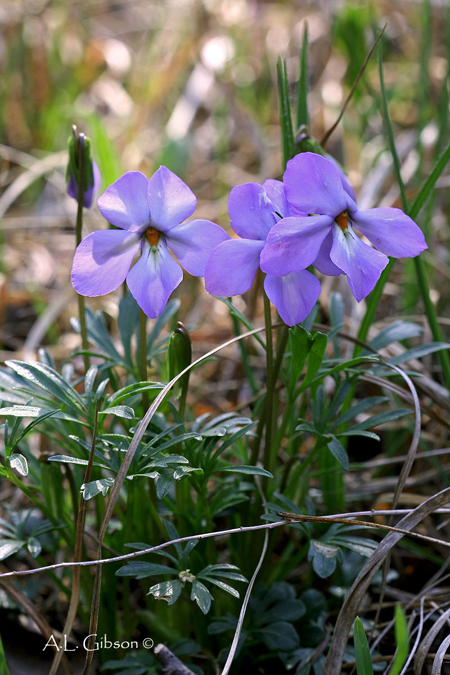
Chasmogamous flowering habit by Andrew Gibson, "Buckeye Botanist" website
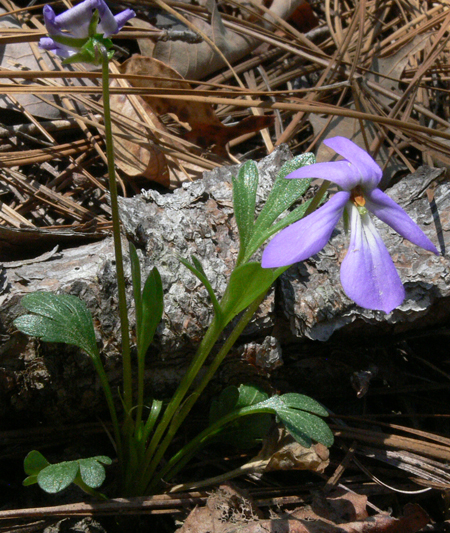
Chasmogamous flowering habit of "ranunculifolia" hybrid phenotype between var. flabellata and var. pedata by Bruce Sorrie

Chasmogamous flower front view by Arthur Haines, Native Plant Trust

Chasmogamous flowering habit from herbarium specimen: WV, Greenbrier Co., Kate's Mountain, J. K. Small s.n. (part of holotype of V. pedataf. cuneatiloba Brainerd ex Fernald)
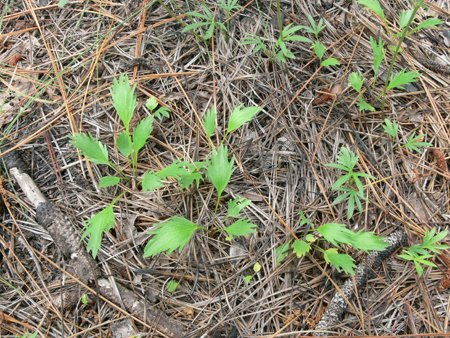
Leaves of var. flabellata (lower left) and var. pedata (upper right) by Bruce Sorrie
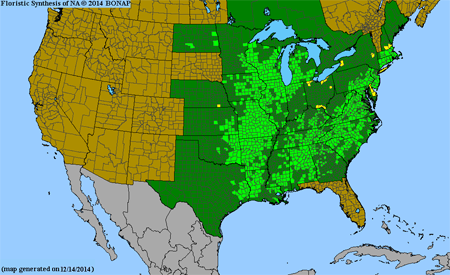
Map of V. pedata by the Biota of North America Program
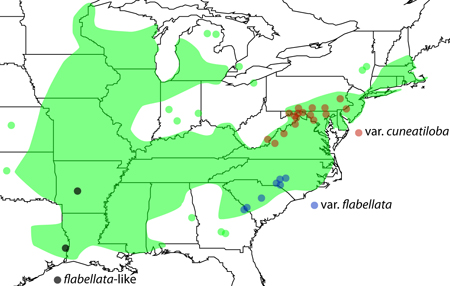
Map of varieties of V. pedata by Harvey Ballard, with var. pedata adapted from Russell (1965)